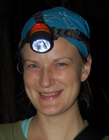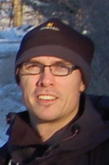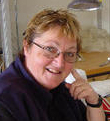|
People
People
People
People
People
|
 |
Professor Annemarie
Surlykke focuses on sound production and echolocation in bats.
Recently her focus has been on the intensity and directivity of the
emitted sonar call and the implications for the way that bats perceive the
world through sound as well as their acoustic interaction with prey.
|
 |
Assistant Professor John
Morgan Ratcliffe
studies the sensory and cognitive ecology of echolocating bats and their
would-be prey, specifically as pertains to behavioural flexibility in bats and
decision-making in insects. |
 |
Post-doc. Signe Brinkløv
researches how Macrophyllum macrophyllum ear, mouth, noseleaf and head movement is correlated with echolocation behavior. |
 |
Post-doc. Lasse Jakobsen
investigates the directionality of bat echolocation signals. |
 |
Ph.D. student Tórur Andreassen is interested in the development of open
systems for scientific use, this has resulted in a scalable acoustic
microphone array, which is based as much as possible on open hardware-
and software components, and as little as possible on custom made
components. |
 |
Ph.D. student Sayedali (Ali) Shekarchi is working on the representation and compression of head-related transfer functions (HRTFs). |
 |
Ph.D. student Kayleigh Fawcett is working on ''The effects of
conspecifics on echolocation in bats''. Her research focuses primarily
on the echolocation of Daubenton's bat in Denmark and the Horseshoe
bats of South Africa and the UK - both in the lab and in the
field. She also has a keen interest in bat conservation - most
recently setting up a bat box scheme in Denmark.
|
 |
Student Line Faber Johannesen investigates call alternation in the phyllostomid bat, Trachops cirrhosus.
The panamanian bat, T. cirrhosus is a so called nose-leafed
bat, echolocating through its nose. Observations have shown that
while the bat is echolocating it opens and closes its mouth, seemingly
in the rhythm of the emitted echolocation calls. My project revolves
around this question: is the bat changing the shape of its
echolocation calls by changing the method of sound
emission, i.e. mouth vs. nose.
|
 |
Student Tanya Bojesen Jensen tries to find out how high the brown
bat Nyctalus noctula is flying when it uses call
alternation. |
 |
Laboratory Technician Vibeke Hepworth keeps everything supplied and running.
|
 |
Students Meike Linnenschmidt and Rasmus Sloth Pedersen work with porpoise biosonar, which provides some interesting comparisons with bat biosonar. |
 |
|
|











